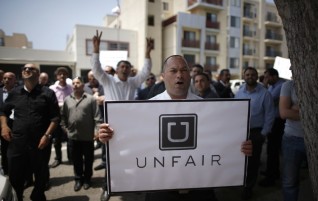
By: Nicole Desbois,
Uber’s 100 million-dollar settlement agreement with its drivers was just recently rejected by a federal Judge in California. The Judge rejected the lawsuit claiming 100 million wasn’t enough to adequately settle the dispute. The issue is whether Uber drivers are contractors or employees entitled to benefits: making Uber venerable to state penalties. If the drivers were to be classified as employees rather than contractors, then 100 million would be “only 10 percent of what lawyers for the drivers estimate that Uber could owe them and provided only $1 million toward state penalties that could add up to more than $1 billion.”[1]
The ruling of the Federal District Judge, Chen, rejected the settlement on the basis of a California law called the Private Attorneys General Act (“PAGA”). PAGA allows “private lawyers to sue companies on behalf of the state government.”[2] Again, in that case the settlement’s 1 million dollars toward state penalties would barely even touch the surface of Uber’s potential future litigation costs and state penalty fees.
It is not entirely clear whether or not Uber Drivers are employee’s rather than contractors. The courts remained undecided, and “‘[t]here is no set definition of the term “independent contractor,”’ according to the California Department of Industrial Relations website.[3] Rather, the state refers to an 11- point test. Is the worker paid per hour or per job? Who supplies the necessary workspace and tools? And, most importantly, how directly does the company control what workers do?”[4] No single factor in this 11-point test is dispositive.[5] The answer is often left up to a juries’ judgment.[6]
For now, the rejection of this settlement offer appears to be a double edge sword. The bright side for Uber driver’s is that Uber may in fact be violating state laws by classifying their employees as contractors. And had the agreement been approved then Uber’s drivers would have remained classified as contractors without employee benefits. Drivers’ now still have the option to either sue in court, or attempt to renegotiate a larger settlement.
However, an arbitration clause in the drivers’ contract could prevent many from participating in a class action lawsuit.[7] Uber has already successfully appealed to one court the classification of many of the drivers’ as a class because a majority of the participants would be in violation of the arbitration clause. [8]
This recent ruling overturned a lower courts ruling that the arbitration clause was not enforceable.[9] However, the drivers’ lawyer, Liss-Riordan, still has a second, separate appeal pending arguing the clause is unenforceable “for a different reason – because it violates the drivers’ rights under the National Labor Relations Act to engage in concerted activity.”[10]
Forcing drivers to bring their claims individually court drastically affect the amount Uber would be required to pay out.[11] The reason for this is many individuals do not seek to pursue arbitration.[12] However, Liss-Riordan is more than ready to pursue this avenue. Claiming already 1,000 drivers have signed up. [13]
The outcome of this lawsuit could have a large scale ripple effect. With the evolution of technology and the ability of companies to outsource work to contractors, employers need to be careful not to cross the line.
Classifying the driver’s as employees may also have negative impacts for the drivers themselves.[14] Although there are no state laws that prohibit employees from working with competitors, i.e. a Lyft driver working for Uber and vice versa, Uber and companies would likely begin to draft in those stipulations.[15]
For now, the issue remains undecided. A decision regarding the arbitration clause is still pending. Until the arbitration clause issue is decided, Uber has successfully requested that the other issues up on trial remain pending.
One thing is for sure, the relationship between employers and contractors is likely to change within the next decade. Some experts within the field of employment contracting believe that on-demand independent contractors could grow to 40% of the workforce by the end of 2020.[16] As the workforce continues to grow towards a trend of independent contractors, employment benefits for contractors should grow too.
[1] Andrea Peterson, Judge: $100 Million Not Enough to Settle Uber Employment Lawsuit, Washington Post (Aug. 19, 2016), https://www.washingtonpost.com/news/the-switch/wp/2016/08/19/judge-100-million-not-enough-to-settle-uber-employment-lawsuit/.
[2] Id.
[3] Adam Brinklow, Year in Preview: What the Uber Lawsuit Means for Workers in the Sharing Economy, SF Weekly, (Dec. 30, 2015), http://uberlawsuit.com/Year%20in%20Preview%20What%20the%20Uber%20Lawsuit%20Means%20for%20Workers%20in%20the%20Sharing%20Economy.pdf.
[4] Id.
[5] See id.
[6] See id.
[7] See Andrea Peterson, Judge: $100 Million Not Enough to Settle Uber Employment Lawsuit, Washington Post (Aug. 19, 2016), https://www.washingtonpost.com/news/the-switch/wp/2016/08/19/judge-100-million-not-enough-to-settle-uber-employment-lawsuit/.
[8] See id.
[9] See id.
[10] Uber Lawsuit, http://uberlawsuit.com (last visited Nov. 21, 2016).
[11] See Curt Woodward, Uber Lawsuit Could Shed Drivers After Settlement, Boston Globe (Aug. 19, 2016), https://www.bostonglobe.com/business/2016/08/19/uber-lawsuit-could-shed-drivers-after-settlement-rejected/G0zhHjOsjqpt7LoOZ3vjKJ/story.html.
[12] See id.
[13] See id.
[14] See Adam Brinklow, Year in Preview: What the Uber Lawsuit Means for Workers in the Sharing Economy, SF Weekly, (Dec. 30, 2015), http://uberlawsuit.com/Year%20in%20Preview%20What%20the%20Uber%20Lawsuit%20Means%20for%20Workers%20in%20the%20Sharing%20Economy.pdf.
[15] See id.
[16] See Elaine Pofeldt, Intuit: On-Demand Workers Will More Than Double by 2020, Forbes (Aug. 13, 2015), http://www.forbes.com/sites/elainepofeldt/2015/08/13/intuit-on-demand-workers-will-more-than-double-by-2020/#7716e3ed679d.
Image Source:
http://blogs-images.forbes.com/dandiamond/files/2015/06/Uber_protest-e1434569997112.jpg
